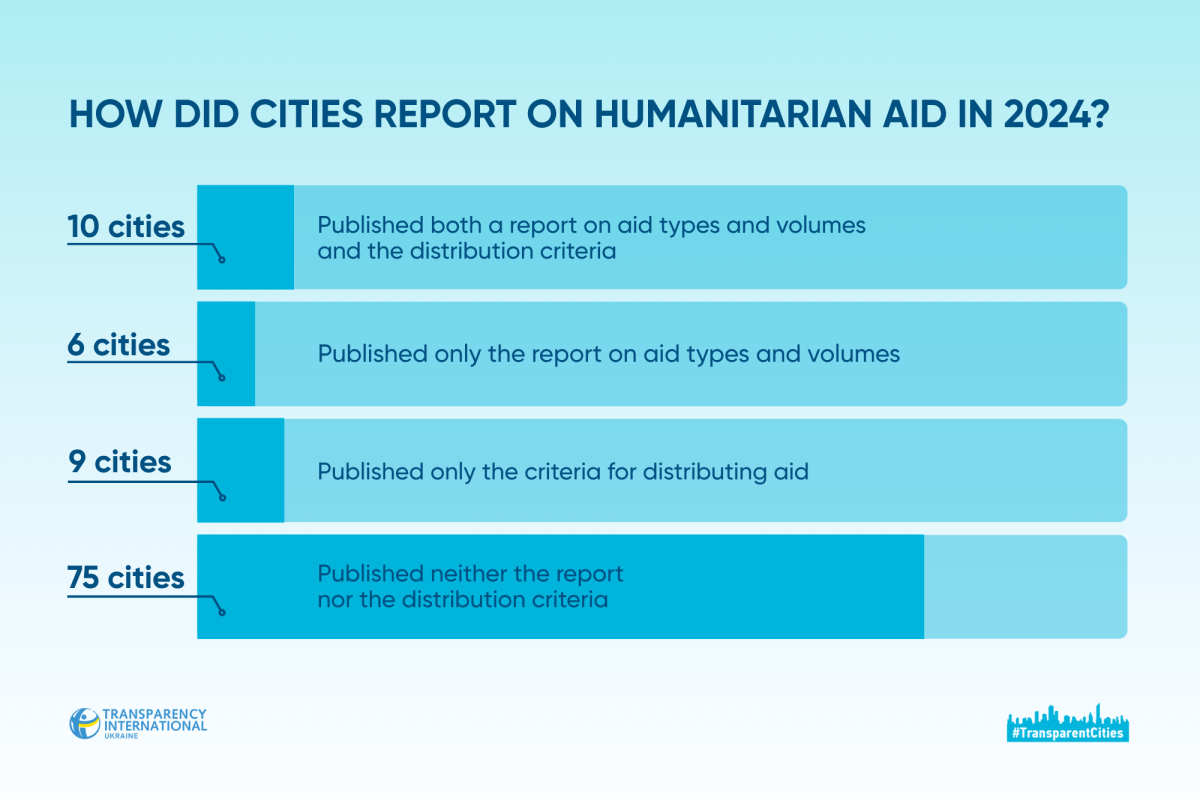

The Transparent Cities program assessed how openly, fairly, and according to what principles city councils report on humanitarian aid. The findings revealed that only 6 out of 100 cities publish all the necessary information about such assistance — Drohobych, Zaporizhzhia, Lozova, Mykolaiv, Chernivtsi, and Shostka.
The program’s experts evaluated several aspects of how humanitarian aid is managed:
- A comprehensive, up-to-date report on the types and volumes of received humanitarian aid. Both the public and international donors and investors should have access to this data to understand what resources are already available in the community and what areas still require support. According to the Law of Ukraine on Humanitarian Aid, recipients must report monthly on the availability and distribution of aid to the relevant state authority. The program reviewed whether city councils had consolidated this data into an annual report and published it on their official websites.
- Aid distribution criteria. While the law does not explicitly require the publication of these criteria, making them publicly available helps build trust. Clear criteria can justify why certain population groups receive aid as a priority and help avoid accusations of favoritism or bias.
- A list of aid recipients. Most recipient entities subordinated to city councils already use the Unified Register of Humanitarian Aid Recipients. Publishing this list on the city’s website would help residents navigate where to seek aid and allow donors to identify relevant partners more easily.
The findings revealed that only 6 out of 100 cities publish all the necessary information about such assistance — Drohobych, Zaporizhzhia, Lozova, Mykolaiv, Chernivtsi, and Shostka.
Only 15 out of 100 municipalities published a consolidated, up-to-date report on the types and volumes of received humanitarian aid. Some cities released a textual summary with key indicators in a reader-friendly format — as in Drohobych. Others referred to broader documents like the mayor’s annual report or the report on the implementation of the Socio-Economic Development Program, as in Sheptytskyi, where aid was mentioned only in passing.
Some municipalities maintain open data records on aid via data.gov.ua or local portals, for example, Dnipro and Bila Tserkva. While helpful for transparent accountability, these datasets are not structured as comprehensive reports that civil society, businesses, or the media can easily use.
Only 10 cities published both an annual report and the criteria or principles for distributing aid. Zlatopil, Kalush, and Lozova adopted specific Procedures for Managing Humanitarian Aid During Martial Law. These documents regulate how aid is received and distributed, assign a responsible authority, and define priority areas for support. Other city councils, like Zaporizhzhia, only provided brief notices on their website or short mentions in their annual reports.
Only 12 out of 100 cities published a list of humanitarian aid recipients with their legal entity codes (USREOU) on their websites. It is crucial that this information be available on the official local government website to ensure its accuracy and relevance. This approach promotes transparency in how aid is received, processed, and distributed, and strengthens public trust. Chernivtsi stands out as a model of good practice, publishing updated lists in a dedicated “Humanitarian Aid” section, with direct links to recipients’ profiles in the Humanitarian Aid Registration System.
Mykolaiv has gone a step further with a dedicated website about humanitarian aid —a unique tool offering not just the annual report on the received humanitarian aid, but also donor statistics, audit information, and a step-by-step guide to the aid journey from request to delivery. This is an exemplary case of proactive transparency in humanitarian aid management.
Among regional centres, only Zaporizhzhia, Mykolaiv, and Chernivtsi met both transparency criteria. Odesa published both a report and distribution criteria but did not provide a full recipient list. Dnipro, Kropyvnytskyi, and Lutsk published only summary reports. Vinnytsia and Khmelnytskyi published only the recipient lists. Meanwhile, no proper information on humanitarian aid was found on the websites of Zhytomyr, Kyiv, Ivano-Frankivsk, Lviv, Poltava, Rivne, Sumy, Uzhhorod, Kharkiv, Cherkasy, or Chernihiv.
“Lack of public information on humanitarian aid creates corruption risks and undermines trust in authorities and their decisions. City councils that don’t prioritize transparency and systematic aid management have fewer chances of attracting investors or effectively coordinating wartime assistance,” said Olesia Koval, Transparent Cities Program Manager.
The review shows that most municipalities have yet to ensure proper transparency in managing humanitarian aid. This fosters public distrust, speculation, and potentially abuse. In wartime, when Ukraine relies heavily on international support, ignoring transparency in this area is extremely risky. Local authorities must use all available tools to prevent abuse and improve coordination between donors and recipients.
Among regional centres, only Zaporizhzhia, Mykolaiv, and Chernivtsi met both transparency criteria.
Recommendations for local self-government bodies
To build a transparent system for tracking and reporting humanitarian aid, cities can take several practical steps:
- Establish a tracking process for received aid: Appoint or create a responsible body to assess and document information about the type, quantity, value, condition, shelf life, storage requirements, donor name, and intended use of each aid item. Example: In Mykolaiv, these functions are performed by the Aid Inspection Commission under the City Headquarters for Humanitarian and Charitable Aid. Selective monitoring is carried out by the Department of Internal Financial Control (see “Aid Distribution Path” section).
- Require the responsible body to publish at least one general report annually in a readable textual format outlining the types and volumes of humanitarian aid* received. Example: The Pokrovsk City Council’s Territorial Social Services Center provides such reports.
The relevant open data set must include detailed information on each item of received aid and be updated in a timely manner (in accordance with the recommendations of the Ministry of Digital Transformation or the local Regulation/Procedure on open data management). Example: Lutsk adheres to these open data formatting recommendations.
*A sample general report on humanitarian aid is available in the “Standard Document Templates” section of the program’s website under the name “Humanitarian Aid Distribution Act.”
- Define and publish clear principles and criteria for distributing humanitarian aid, preferably through an official regulatory document, such as a Procedure for Humanitarian Aid Management. This ensures a systematic process and helps prevent abuse. Example: Lozova City Council’s official procedure serves as a strong model.
*A template procedure can also be downloaded from the “Templates” section.
If a formal procedure is not yet in place, publish at least the criteria as an article or notice on the city council’s website.
- Publish a list of aid recipients among structural units, municipal enterprises, institutions, and organizations subordinated to the city council. This list must include full institution names and their USREOU codes.
Check whether the entries in the Automated Humanitarian Aid Registration System match those in your published list, including address, USREOU code, aid received, etc. Provide a link to the registration system or follow Mukachevo’s example of linking individual entities directly.
- Create a dedicated section or page for humanitarian aid on the city council’s official website. Include all relevant documents (such as reports, recipient lists, and links to the System) and ensure the page is logically structured and easy to navigate.
Recommendations for citizens
If you know your city receives humanitarian aid but can’t find more than a few announcements on the website or social media:
- Submit a public information request to the city council — by email or through local/national citizen request platforms.
- The city council must respond to an information request within five working days. If they refuse, delay, or improperly disclose the information, you have a legal basis to challenge their actions:
- by submitting a complaint to the information manager’s leadership;
- by contacting the Ukrainian Parliament Commissioner for Human Rights (Ombudsman);
- by filing a claim in administrative proceedings.
Transparency is not just about open numbers — it’s about trust, oversight, and fairness in how public resources are distributed. When local authorities fail to report systematically on humanitarian aid, residents must become agents of change. Asking, verifying, and demanding proper information is everyone’s right — and it can make governance more open and aid more accessible.







